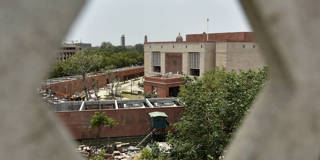The design of a legislative chamber should serve two functions: it should help citizens understand who stands for what in political conflicts, and it should enable deputies to hold a government accountable with maximum publicity. How does India's new parliament building measure up?
PRINCETON – Is there an ideal design for parliament buildings and legislative chambers? The question seems abstract, but it comes up surprisingly often as a very concrete challenge. It arose in the 1990s, when Scotland needed an assembly following decentralization in the United Kingdom. It also appears when countries – including Brazil in the 1950s, Nigeria in the 1980s, and Indonesia today – construct new capital cities. And it may emerge when a country decides – as India recently did – that a new parliament building can distance it from the legacy of colonialism.
The new building that Indian Prime Minister Narendra Modi recently inaugurated is part of a comprehensive redesign of Central Vista, the government district in New Delhi. Modi, a consummate architect of his own personality cult, was heavily criticized for leading the ceremony himself, rather than allowing the president to do it. Twenty opposition parties boycotted the event.
Despite the controversy over the ceremony, and complaints about the project’s costs, the interior of the triangular building – which replaces a structure created during the Raj – appears relatively uncontentious. Nonetheless, one has to wonder how well the edifice represents or, more important, facilitates democratic politics. As Winston Churchill once quipped, first “we shape our buildings, and afterwards our buildings shape us.”

PRINCETON – Is there an ideal design for parliament buildings and legislative chambers? The question seems abstract, but it comes up surprisingly often as a very concrete challenge. It arose in the 1990s, when Scotland needed an assembly following decentralization in the United Kingdom. It also appears when countries – including Brazil in the 1950s, Nigeria in the 1980s, and Indonesia today – construct new capital cities. And it may emerge when a country decides – as India recently did – that a new parliament building can distance it from the legacy of colonialism.
The new building that Indian Prime Minister Narendra Modi recently inaugurated is part of a comprehensive redesign of Central Vista, the government district in New Delhi. Modi, a consummate architect of his own personality cult, was heavily criticized for leading the ceremony himself, rather than allowing the president to do it. Twenty opposition parties boycotted the event.
Despite the controversy over the ceremony, and complaints about the project’s costs, the interior of the triangular building – which replaces a structure created during the Raj – appears relatively uncontentious. Nonetheless, one has to wonder how well the edifice represents or, more important, facilitates democratic politics. As Winston Churchill once quipped, first “we shape our buildings, and afterwards our buildings shape us.”